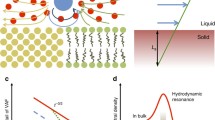Abstract
The Fokker–Planck (FP) equation describing the dynamics of a single Brownian particle near a fixed external surface is derived using the multiple-time-scales perturbation method, previously used by Cukier and Deutch and Nienhuis in the absence of any external surfaces, and Piasecki et al. for two Brownian spheres in a hard fluid. The FP equation includes an explicit expression for the (time-independent) particle friction tensor in terms of the force autocorrelation function and equilibrium average force on the particle by the surrounding fluid and in the presence of a fixed external surface, such as an adsorbate. The scaling and perturbation analysis given here also shows that the force autocorrelation function must decay rapidly on the zeroth-order time scale τ 0, which physically requires N Kn≪1, where N Kn is the Knudsen number (ratio of the length scale for fluid intermolecular interactions to the Brownian particle length scale). This restricts the theory given here to liquid systems where N Kn≪1. For a specified particle configuration with respect to the external surface, equilibrium canonical molecular dynamics (MD) calculations are conducted, as shown here, in order to obtain numerical values of the friction tensor from the force autocorrelation expression. Molecular dynamics computations of the friction tensor for a single spherical particle in the absence of a fixed external surface are shown to recover Stokes' law for various types of fluid molecule–particle interaction potentials. Analytical studies of the static force correlation function also demonstrate the remarkable principle of force-time parity whereby the particle friction coefficient is nearly independent of the fluid molecule–particle interaction potential. Molecular dynamics computations of the friction tensor for a single spherical particle near a fixed external spherical surface (adsorbate) demonstrate a breakdown in continuum hydrodynamic results at close particle–surface separation distances on the order of several molecular diameters.
Similar content being viewed by others
REFERENCES
R. Lamanna, M. Delmelle, and S. Cannistraro, Solvent Stokes-Einstein violation in aqueous protein solutions, Phys. Rev. E 49:5878–5880 (1994).
R. Lamanna and S. Cannistraro, Water proton self diffusion and hydrogen bonding in aqueous human albumin solutions, Chem. Phys. Lett. 164:653–656 (1989).
M. H. Peters, Nonequilibrium molecular dynamics simulation of free molecule gas flows in complex geometrices with application to Brownian motion of aggregate aerosols, Phys. Rev. E 50:4609–4617 (1994).
R. I. Cukier and J. M. Deutch, Microscopic theory of Brownian motion: The multiple-time scale point of view, Phys. Rev. 177:240–244 (1969).
G. Nienhuis, On the microscopic theory of Brownian motion with a rotational degree of freedom, Physica 49:26–48 (1970).
J. Piasecki, L. Bocquet, and J.-P. Hansen, Multiple time scale derivation of the Fokker-Planck equation for two Brownian spheres suspended in a hard sphere fluid, Physica A 218:125–144 (1997).
J. Piasecki, Time scales in the dynamics of the Lorentz electron gas, Am. J. Phys. 61:718–722 (1993).
J. T. Hynes, Transient initial condition effects for Brownian particle motion, J. Chem. Phys. 59:3459–3467 (1973). Also see: E. L. Chang and R. M. Mazo, On the Fokker-Planck equation for the linear chain, Mol. Phys. 28:997–1004 (1974).
R. M. Mazo, On the theory of Brownian motion. II. Nonuniform systems, J. Stat. Phys. 1:101–106 (1969).
T. J. Murphy and J. L. Aguirre, Brownian motion of N interacting particles, J. Chem. Phys. 57:2098 (1972).
M. H. Peters, Phase space diffusion equations for single Brownian particle motion near surfaces, Chem. Eng. Comm. 108:165–184 (1991).
D. W. Heermann, Computer Simulation Methods in Theoretical Physics, 2nd Ed. (Springer-Verlag, New York, 1990). An alternative method to velocity rescaling is the use of Nosé-Hoover Mechanics: S. Nosé, J. Chem. Phys. 81:511 (1984); W. G. Hoover, Phys. Rev. A 31:1695 (1985).
M. P. Allen and D. J. Tildesley, Computer Simulation of Liquids (Oxford Science Publications, New York, 1989).
J. M. Haile, Molecular Dynamics Simulation (Wiley, New York, 1992).
D. Tabor, Gases, Liquids and Solids and Other States of Matter, 3rd Ed. (Cambridge, New York, 1991).
W. E. Alley and B. J. Alder, Phys. Rev. A. 27:3158–3173 (1983). B. J. Alder and W. E. Alley, Physics Today, January, 56–63, 1984. Also see J. J. Brey and J. G. Ordóñez, J. Chem. Phys. 76:3260–3263 (1982).
J. P. Boon and S. Yip, Molecular Hydrodynamics (McGraw-Hill, New York, 1980).
P. S. Epstein, On the resistance experienced by spheres in their motion through gases, Phys. Fluids 1:710–733 (1923).
G. M. Torrie, P. G. Kusalik, and G. N. Patey, Molecular solvent model for an electric double layer, J. Chem. Phys. 88:7826–7840 (1988).
D. J. Jeffrey and Y. Onishi, Calculation of the resistance and mobility functions for two unequal rigid spheres, J. Fluid Mechanics 139:261–290 (1984).
M. Vergeles, P. Keblinski, J. Koplik, and J. R. Banavar, Stokes drag at the molecular level, Phys. Rev. Lett. 75:232–235 (1995).
L. Bocquet, L., J.-P. Hansen, J. Piasecki, Friction tensor for a pair of Brownian particles, J. Stat. Phys. 89:321–347 (1997).
S. Asakura and F. Oosawa, Interaction between particles suspended in solutions of macromolecules, J. Polymer Sci. 33:183–192 (1958).
M. H. Peters, Combined rotational and translational motions of an arbitrarily-shaped Brownian particle near a surface, J. Chem. Phys., to appear (1999).
Author information
Authors and Affiliations
Rights and permissions
About this article
Cite this article
Peters, M.H. Fokker–Planck Equation, Molecular Friction, and Molecular Dynamics for Brownian Particle Transport near External Solid Surfaces. Journal of Statistical Physics 94, 557–586 (1999). https://doi.org/10.1023/A:1004552421971
Issue Date:
DOI: https://doi.org/10.1023/A:1004552421971




